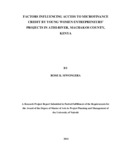| dc.description.abstract | Entrepreneurship is actually progressively recognized as a vital driver on economic
growth, productiveness, creativity as well as career, which is generally recognized as
being essential area of economic dynamism. Up to the recent past, the significant
numbers of enterprises were owned by men. As such it was not possible to see womenowned
businesses worldwide particularly in developing countries. Microfinance credit
has now become a major tool of development and is fast developing as an international
industry with its own trade associations. Microfinance credit seeks to provide practical,
workable solutions to the deep-seated challenges of poverty particularly to women who
for longtime they have been sidelined with perception that they are inferior. The purpose
of this study was to investigate factors influencing the access to microfinance credit by
young women entrepreneurs in Athi River Sub-County. The study was guided by four
objectives which were; to assess whether interest rates charged, level of literacy, number
of lending institutions and demand for collateral security have any influence on access to
micro-finance credit among young women entrepreneurs in Athi River. The study
employed descriptive research design. According to Athi-River Municipality (2013),
there are 270 enterprises run by women under 35 years. This study adopted Krejcie and
Morgan theory of determining sample size thereby acquiring a sample of 165
respondents. The study relied mostly on primary data where self-administered
questionnaires were utilized for gathering data. Data collected purely was quantitative.
Quantitative data was coded and entered into Statistical Packages for Social Scientists
and analyzed using descriptive statistics. The findings are presented inform of frequency
tables and explanation is in prose. The study established that majority of the young
women entrepreneurs had borrowed money from the nearby micro-finance institutions
the loan accrues interest rate imposed by the financial institutions as well as demand for
collateral security and they found it unreasonable. The study also found out that most of
the entrepreneurs had attained secondary school certificate as their highest academic
qualification and was a determinant for uptake of loans. Finally, the study established that
licensing of more financial institutions would encourage uptake of loan among women
entrepreneurs since uptake of loan is low and this would influence business performance.
The study concluded that lack of collateral security has become a constraint to young
women entrepreneurs accessing loans since most of them may not have deeds to capital
assets to present as security against the loans and that most of young women
entrepreneurs have had loans applied for rejected due to failure to produce collateral
security. Finally, the study recommends that for the under-privileged women to access
credit, alternative approaches on collateral security requirements get adopted through the
emphasis on social capital tools such as trust and network relations for securities. It also
recommends that the government offers deliberate and targeted training to the young
women entrepreneurs in order to encourage entrepreneurship culture hence creation of
job opportunities. Government should also ensure policies that are friendly to creation of
more lending institutions. | en_US |

